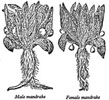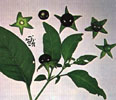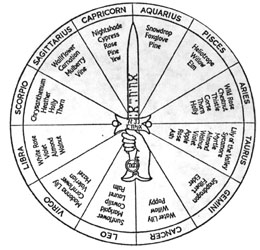
Gothic Gardening: Theme Gardens
The Witches' Garden
Of course, we all know witches don't exist. Neither do vampires. But
once
upon a time, there were strange old women who lived on the fringes of
society, and practiced herbal 'medicine', and not always for good. Normal,
decent folk, who wanted to protect themselves, made sure they found out
just what sorts of things a witch would grow in her garden, so that they
could identify her with ease....
- Witches' Thimbles
| Foxglove, which has large tubular flowers.
It's also the original source of digitalis, a heart medication.
This plant was used for 'trial by ordeal' in medieval Italy. |  |
- Love Apples
- Tomatoes. The name, and the supposedly
aphrodisiacal effect, resulted from a mistranslation of the name by
the French. Since these are related to belladonna and several other
poisonous plants, people were still arguing about whether too many
tomatoes could be deadly as late as the 17th century. Perhaps a nice
black variety would go well in your witch garden...
- Hemlock
| ah, root of hemlock, "digg'd i' the dark". Not the tree,
but an herb that's a member of the carrot family, and a deadly
poison. This is also known as Fool's Parsley. |  |
- Monkshood
| Supposedly the 'quintessential plant of the occult'.
It has beautiful purple flower spikes. It was used in combination
with belladonna to make a flying ointment, and in combination
with water parsnip, cinquefoil, belladonna, and soot to make an
ointment of the imagination, that allowed witches to contact the
other side. It contains the deadly poison aconitine, which slows heart
rate, decreases blood pressure, and numbs pain. The ancient Greeks
believed monkshood sprouted from the spittle of the hellhound Cerberus. |  |
- Wolf's Bane
- Closely related to monkshood, this is often
confused with it. This plant, which has small yellow flowers, is
often just referred to as Aconite. One recipe from 16th century Naples
has a mix of aconite and English yew, with powered glass, caustic
lime, arsenic, bitter almonds, and honey, formed into pills.
- Mandrake
| A plant with many fables surrounding it. The twisted,
elaborate root was thought to look like a man, and people thought
it screamed when it was pulled out of the ground. Dogs were used
to pull roots up, because supposedly the dog always died
afterwards. This root has a narcotic effect. |  |
- Vervaine
- Better known as verbena, this was used for love
potions. It had to be dug up with a piece of gold or a stag's
horn on the Saints Days, June 27 and July 25. Often used with
endive seed.
- Opium Poppy
| This isn't illegal to grow, unless you havelarge fields of poppies. Shakers used to give an
opium syrup to high strung children. This poppy is the symbol of
sleep and dreams. My favorite quote is from Jean Cocteau: "Opium is
the only vegetable substance that communicates the vegetable state to
us." |  |
- Yarrow
- Used for a wound poultice with plantain leaves. This was
still used during the Civil War. This was considered one of the
devil's favorite plants, and was known as Devil's Nettle.
- Dill
- Dill water was used to soothe baby's colic.
- Cumin
- Used extensively for love potions.
- Deadly Nightshade
| Not to be confused with the non-deadly
variety, this one(Atropa belladonna) is related to the potato, the tomato, and many other poisonous plants, and is also known as
Belladonna. It's the source of the drug atropine, which has wide
ranging nervous effects. It has purplish-red flowers and
poisonous berries. Once ladies would use belladonna extract too
dilate their pupils. |  |
- Poplar trees
- I'm not sure why witches had such a fascination
with the tree, except that they used it in combination with
monkshood, hemlock, and soot to make a deadly poison. Some other
trees they had an affinity for are alder, larch, and cypress.
- Feverfew
- useful for relieving migraines, this is used
extensively today.
- Tobacco
- Witches supposedly used it for a soporific effect.
- Thorn Apple
| Known now as Jimson Weed, this plant has hallucinogenic
effects. The name derives from the prickly fruits, and the juice
from these fruits was applied to the mothers' nipples to kill
unwanted infants. |  |
- Henbane
- A close relative of Thorn Apple and the nightshades, henbane was also used in the preparation of "flying ointments"
- Parsley
- Supposedly parsley seed goes nine times to the devil and
back before it comes up, which is why you never get 100%
germination...
- Meadow Saffron
- This is not the same as culinary saffron. This was used
for gout and arthritis, and too much can cause head pain and vomiting.
Witches used it for its supposed soporific effect.
- Alkanet
- This is used to make a red dye, and it was believed that if it
was applied to the 'privities' it would draw forth a dead child.
Witches would have three or four rows of red flowers (geraniums, nasturtiums,
red-hot pokers) surrounding her garden as a defense against witch hunters.
These flowers were known as "witch soldiers". Herbs for black magic had to be
gathered during certain phases of
the moon, and they had to be gathered from a spot that the sun had not
touched, since witches' work cannot stand the light of day. It was
best to collect an odd number of sprigs, and best was 7 or 9.
To make potions, three kinds of wood had to be used to boil the water.
Witches would also keep a variety of different flowers growing in the garden,
so that she had flowers from every group in her flora chart. This would allow
her to have power over people with every birthsign.

A Witch's Flora Chart
Now you have enough to plant a nice size witches' garden. However,
if you don't want witches coming in and using all your plants,
you could plant a border around it that bloomed in yellow or
green flowers. Witches will never cross a hedge such as this,
since it reminds them of the sun, which they abhor.
Note: I am using the term 'witch' only in it's folklorish sense. No pagans
or modern witches were harmed in the creation of this segment of Gothic
Gardening, so don't get offended. Don't write me and tell me you
do exist, since folklore witches don't exist. If you want a garden
more inclined toward the modern pagan, try the Wicca Garden.
Main Index
Gothic Gardening is copyright (c) 1995-1997
by Alice Day (mAlice).
All Rights Reserved.
--unless otherwise attributed--








